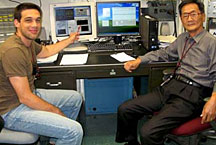- Number 365 |
- June 18, 2012
Scientists take a giant step forward in understanding plutonium

Georgios Koutroulakis and H. Yasuoka
in the condensed-matter NMR lab at
Los Alamos National Laboratory after
having observed the magnetic
resonance signal of Pu-239 for
the first time.
Nuclear magnetic resonance offers new insights into the element
Plutonium is the most complex element in the periodic table, yet it is also one of the most poorly understood ones. But now a well-known scientific technique, nuclear magnetic resonance (NMR) spectroscopy, may turn out to be the perfect tool for uncovering some of plutonium’s mysteries. Scientists at DOE's Los Alamos National Laboratory (LANL) and the Japan Atomic Energy Agency (JAEA) have detected the faint signal of plutonium-239’s unique nuclear magnetic resonance signature.
This signal promises to become a Rosetta stone for deciphering the complex atomic-scale electronic properties of this perplexing element. Their paper on the subject, "Observation of 239Pu Nuclear Magnetic Resonance," was published in the May 18 issue of Science magazine.
A team led by visiting professor Hiroshi Yasuoka (JAEA) and Georgios Koutroulakis (LANL) observed the plutonium-239 resonance from a high purity solid sample of plutonium dioxide, PuO2, at a temperature of 4 Kelvin as a function of magnetic field.
"Just as knowing the NMR properties of other nuclei has advanced so significantly our ability to understand complex materials and phenomena as well as to image matter on a microscopic scale," said Koutroulakis, "this discovery of the plutonium-239 magnetic resonance promises to revolutionize our understanding of plutonium solid state physics, chemistry, biology and materials science."
Link to full story: http://www.lanl.gov/news/releases/scientists_take_giant_step_forward_in_understanding_plutonium.html
[Nancy Ambrosiano, 505.667.0471,
nwa@lanl.gov]
